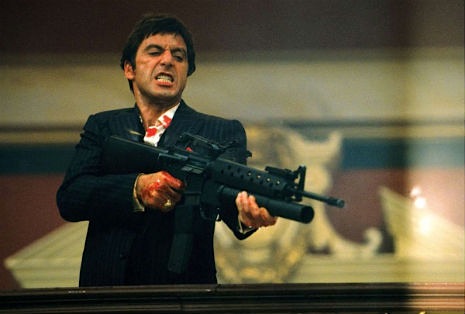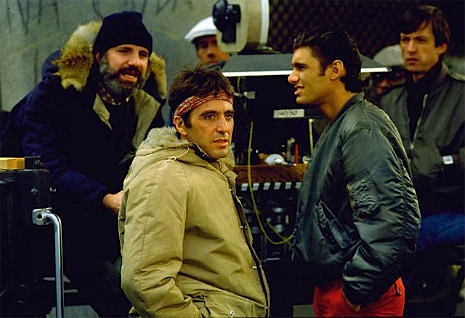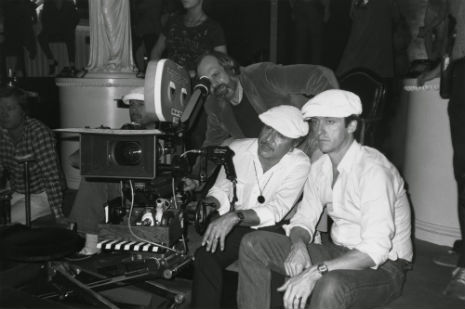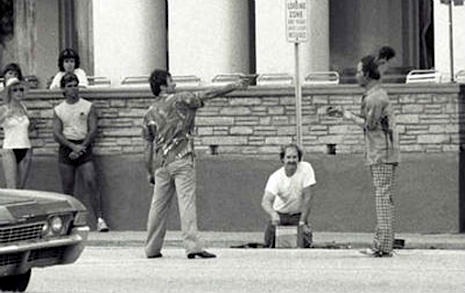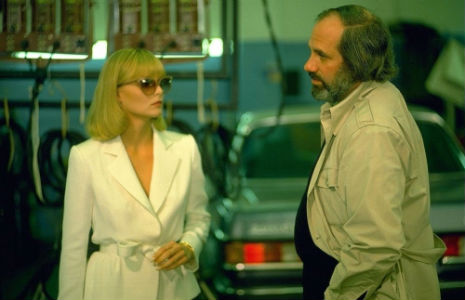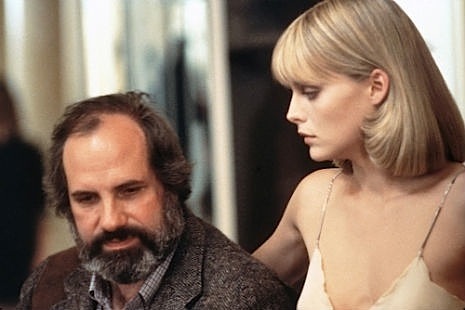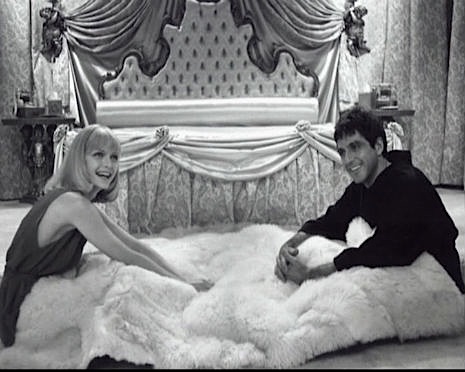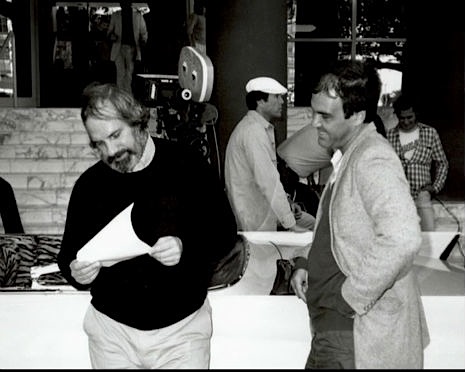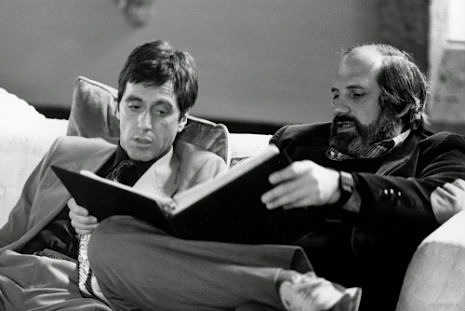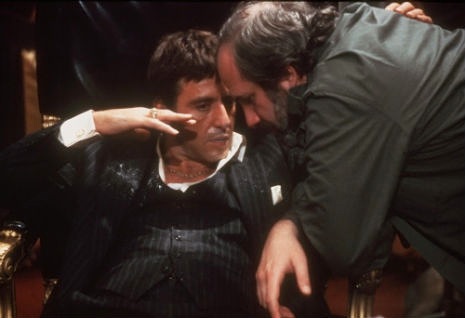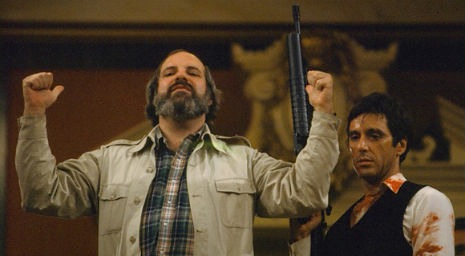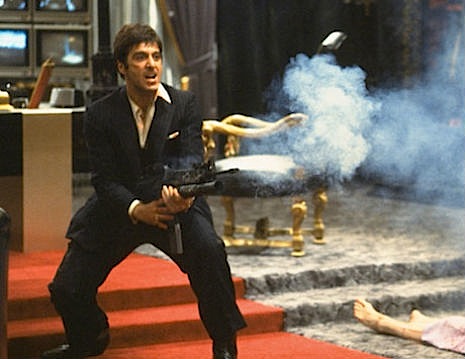It's in my eyes, and it doesn't look that way to me, In my eyes. - Minor Threat
Saturday, January 31, 2015
The Art of Letterpress | Crafting a beautiful book
The Folio Society interviewed master printer Stan Lane about the classic craft of letterpress printing. "Feeling print in paper... you know someone's actually been there."
Fun fact from the film: Lane says we call it a type face because a physical piece of type has a foot, a body, a shoulder, and a face. The face is the only part that gets pressed into the paper.
Friday, January 30, 2015
Rock Balancing
via Boing Boing
Stone Balance and Videography
by Michael Grab
random video clips recorded throughout 2014
http://www.gravityglue.com
More info: http://gravityglue.com/gravity-glue-2014
All Rights Reserved
All video clips are under copyright and ownership of Michael Grab (www.gravityglue.com)
Thursday, January 29, 2015
A new Evel Knievel documentary premiering at Sundance
Dope poster! with Matt hoffman on board as well as Johnny Knoxville, i've got high hopes for this one.
from EW:

Sundance exclusive: Johnny Knoxville promises 'big revelations' in Evel Knievel doc
Evel Knievel is synonymous with daredevil, but unless you saw him at his heights in the late 1960s and early 1970s, it’s difficult to imagine how he built that reputation into something millions of people actually cared about. Beginning with Knievel’s disastrous attempt to jump the fountains at Caesar’s Palace in 1967—which made him a star once it aired on ABC’s Wide World of Sports—millions tuned into his stunts to see if he could defy death one more time.
In Being Evel, the documentary that debuts on Jan. 25 at the Sundance Film Festival, director Daniel Junge (They Killed Sister Dorothy) tells the real story of Robert Craig Knievel, the charismatic showman who discovered the most lucrative way to support his family was to risk life and limb in highly orchestrated and heavily promoted motorcycle leaps.
If it sounds hokey in hindsight, it wasn’t so at the time—and a generation of kids eagerly inhaled the danger and the glamour. One of those was Johnny Knoxville, who brought Knievel’s rebellious and thrill-seeking spirit to the Jackass stunts that made his crew famous. “I think we’re hovering right somewhere in between bravery and stupidity,” Knoxville admits, describing the thin line that he and his idol straddled. “Possibly more on the stupidity side.”
Knoxville teamed up with Junge, and producer pals Jeff Tremaine and Mat Hoffman to reexamine Knievel’s life—not just the showstopping highlights everyone remembers, but the tough behind-the-scenes events and relationships that were kept mostly out of the spotlight. “We take a very honest look back on his life,” says Knoxville. “He lived a certain way and we talk about that. We worked a lot with [Evel’s son] Kelly Knievel and the family and couldn’t have made it without the family being involved.”
Knoxville, who’s currently playing Elvis’s bodyguard Sonny West in Elvis & Nixon, with Kevin Spacey and Michael Shannon, spoke to EW about his hero in advance of the doc’s Sundance premiere. And EW also has the exclusive poster for Being Evel, which demonstrates how he liked to live close to the edge.
EW: When I was a kid, I had this awesome Evel Knievel crank-up motorcycle doll that would rev up and fly across the wooden floors in my house. It was the best. I didn’t really understand who or what he was in real life, but he was this super-sized personality—almost this indestructible human doll because of the things he did.
JOHNNY KNOXVILLE: He was a superhero, a real living superhero. That doll is probably my favorite toy of all time. I think a lot of guys who grew up in the time we did feel the same exact way about it. I bought a couple—one for my son when he got old enough and another for me last year. I got the vintage one, still in the original box. My kid loves it, and I love it as much as I did when I was little.
EW: The great thing about it was that it wasn’t perfect; it would go for only so far before wiping out. But hey, that’s exactly what Evel did too.
JK: Exactly. Evel didn’t land it every time. [Laughs]
EW: It’s not difficult to see how Evel’s DNA is sprinkled into what you’ve done with the Jackass crew over the years.
JK: [Evel’s] spirit hangs over Jackass and inspired all of us, and we teamed up with Mat Hoffman, who’s our generation’s Evel Knievel and who has a friendship with the Knievel family. So we all did this together out of our love for Evel. The doc focuses on all of his immense accomplishments, but also what his life has spawned. You know, there would not be an X Games without Evel. No one ever went for it, laid it all on the line, like Evel Knievel. You watch the X Games, and they are laying it all on the line. And that spirit came from Evel, I believe.
read the rest of the interview HERE.
here's a short talk with the director
No Doubt Looking Forward to this!!
Wednesday, January 28, 2015
INSTITUTIONALIZED covered by Ice-T's Body Count
NSFW - Don't watch if you don't have a sense of humor!
and the original that i produced :
Tuesday, January 27, 2015
Get Inspired during the Noreaster...
POSITIVE FORCE: MORE THAN A WITNESS
30 Years of Punk Politics in Action

This is a really good documentary that you should watch and own, and share it with everyone you know.
Kudos to the film makers and all the participants, job well done! Thank You.
-GEF
Positive Force: More Than a Witness - Trailer from Bell Visuals on Vimeo.
rent or digitally buy the film HERE
or OWN the DVD by getting it here from PM Press
This feature-length film by Robin Bell skillfully mixes rare archival footage (including electrifying live performances from Fugazi, Bikini Kill, Rites of Spring, Nation of Ulysses, Anti-Flag, and more) with new interviews of Positive Force activists including co-founder Mark Andersen (co-author of Dance of Days) and Jenny Toomey (Simple Machines) as well as supporters such as Ian MacKaye, Jello Biafra, Dave Grohl, Ted Leo, Riot Grrrl co-founders Kathleen Hanna and Allison Wolfe, and many more.
Covering a span of 30 years, More Than A Witness documents the group’s origins, the creation of its communal house, FBI harassment, and the rise of a vibrant underground that burst into the mainstream amidst controversy over both the means and the ends of the movement. In the best punk fashion, Positive Force has applied creative DIY tactics and radical critiques to issues of homelessness, hunger, racism, corporate globalization, sexism, homophobia, war, gentrification, aging, and animal/ earth liberation, while struggling to constructively address conflicting dynamics and visions within the group itself.
Monday, January 26, 2015
7 Huge Misconceptions About Communism (and Capitalism)
Most of what Americans think they know about capitalism and communism is total nonsense. Here's a clearer picture.
The mirror-image of the “oppressive communism” myth is the “liberatory capitalism” one. The idea that we’re all going around making free choices all the time in an abundant market where everyone’s needs get met is patently belied by the lived experience of hundreds of millions of people. Most find ourselves constantly stuck between competing pressures and therefore stressed out, exhausted, lonely, and in search of meaning. — as though we’re not in control of our lives.
We aren’t; the market is. If you don’t think so, try and exit “the market.” The origin of capitalism [5] was depriving British peasants of their access to land (seizure of property, you might call it), and therefore their means of subsistence, making them dependent on the market for their survival. Once propertyless, they were forced to flock to the dreck, drink and disease of slum-ridden cities to sell the only thing they had – their capacity to use their brains and muscles to work – or die. Just like them, the vast majority of people today are deprived of access to the resources we need to flourish, though they exist in abundant quantities, so as to force us to work for a boss who is trying to get rich by paying us less and working us harder.
Even that boss (the apparent victor in the “free exchange”) isn’t free: the market places imperatives on the ownership class to relentlessly accumulate wealth and develop the forces of production or else fail. Capitalists are compelled to support oppressive regimes and wreck the planet, as a matter of business, even as they protest good personal intentions [6].
And that’s just the principle of the system. The US’s particular brand of capitalism required exterminating a continent’s worth of indigenous people and enslaving millions of kidnapped Africans. And all the capitalist industry was only possible because white women, considered the property of their fathers and husbands, were performing the invisible tasks of child-rearing and housework, without remuneration. Three cheers for free exchange.
3. Communism killed 110 million* people for resisting dispossession.
*The number cited is as consistent as it is rooted in sound research; i.e., not.
Greg Gutfeld, one of the hosts of Fox News’ “The Five” and a historical scholar of zero renown, recently advanced the position [7] that “only the threat of death can prop up a left-wing dream, because no one in their right mind would volunteer for this crap. Hence, 110 million dead.” In declaring this, Gutfeld and his ilk insult the suffering of the millions of people who died under Stalin, Mao, and other 20th Century Communist dictators. Making up a big-sounding number of people and chalking their deaths up to some abstract “communism” is no way to enact a humanistic commitment to victims of human rights atrocities.
For one thing, a large number of the people killed under Soviet communism weren’t the kulaks everyone pretends to care about but themselves communists [8]. Stalin, in his paranoid cruelty, not only had Russian [9] revolutionary [10] leaders assassinated [11] and executed [12], but indeed exterminated entire communist parties. These people weren’t resisting having their property collectivized; they were committed to collectivizing property. It is also worth remembering that the Soviets had to fight a revolutionary war – against, among others, the US [13] – which, as the American Revolution is enough to show, doesn’t mainly consist of group hugs. They also faced (and heroically defeated) the Nazis, who were not an ocean away, but right on their doorstep.
So much for the USSR. The most horrifying episode in 20th Century official Communism was the Great Chinese Famine [14], its death toll difficult to identify, but surely in the tens of millions. Several factors evidently contributed to this atrocity, but central to it was Mao’s “Great Leap Forward,” a disastrous combination of applied pseudoscience, stat-juking, and political persecution designed to transform China into an industrial superpower in the blink of an eye. The experiment’s results were extremely grim, but to claim that the victims died because they, in their right minds, would not volunteer for “a left-wing dream” is ludicrous. Famine is not a uniquely “left-wing” problem.
4. Capitalist governments don’t commit human rights atrocities.
Whatever one’s assessment of the crimes committed by Communist leaders, it is unwise for capitalism’s cheerleaders to play the body-count game, because if people like me have to account for the gulag and the Great Sparrow campaign, they’ll have to account for the slave trade, indigenous extermination, “Late Victorian Holocausts[15]” and every war [16], genocide [17] andmassacre [18] carried out by the US and its proxies in the effort to defeat communism. Since the pro-capitalist set cares so deeply for the suffering of the Russian and Chinese masses, perhaps they’ll even want to account for the millions of deaths [19] resulting from those countries’ transitions to capitalism.
It should be intuitive that capitalism, which glorifies rapid growth amidst ruthless competition, would produce great acts of violence and deprivation, but somehow its defenders are convinced that it is always and everywhere a force for righteousness and liberation. Let them try to convince the tens of millions of people who die of malnutrition [20] every year because the free market is incapable of engineering a situation in which less than half of the world’s food is thrown away [21].
The 100 million deaths that are perhaps most important to focus on right now are the ones that international human rights organization DARA projected [22] will die climate-borne deaths between 2012 and 2030. 100 million more will follow those, and they will not take 18 years to die. Famine like the human species has never known is in the offing [23] because the free market does not price carbon and oil-extracting capitalist firms have, since the collapse of the USSR, become sovereigns of their own[24]. The most virulent anti-communists have a very handy, if morally disgraceful, way of treating this mass extinction event: they deny that it’s happening.
5. 21st Century American communism would resemble 20th century Soviet and Chinese horrors.
Before their revolutions, Russia and China were pre-industrial, agricultural, largely illiterate societies whose masses were peasants spread out over truly vast expanses of land. In the United States today, robots make robots, and less than 2% of population works in agriculture. These two states of affairs are incalculably dissimilar. The simple invocation of the former therefore has no value as an argument about the future of the American economy.
For me, communism is an aspiration, not an immediately achievable state. It, like democracy and libertarianism, is utopian in that it constantly strives toward an ideal, in its case the non-ownership of everything and the treatment of everything – including culture, people’s time, the very act of caring, and so forth – as dignified and inherently valuable rather than as commodities that can be priced for exchange. Steps towards that state of affairs needn’t include anything as scary as the wholesale and immediate abolition of markets (after all, markets predate capitalism by several millennia and communists love a good farmer’s market). Rather, I contend [25] they can even include reforms with support [26] among broadly ideologically [27] divergent parties.
Given the technological, material, and social advances of the last century, we could expect an approach to communism beginning here and now to be far more open, humane, democratic, participatory and egalitarian than the Russian and Chinese attempts managed. I’d even argue it would be easier now than it was then to construct a set of social relations based on fellowship and mutual aid (as distinct from capitalism’s, which are characterized by competition and exclusion) such as would be necessary to allow for the eventual “withering away of the state [28]” that libertarians fetishize, without replaying the Middle Ages (only this time with drones and metadata).
6. Communism fosters uniformity.
Apparently, lots of people are unable to distinguish equality from homogeneity. Perhaps this derives from the tendency of people in capitalist societies to view themselves primarily as consumers: the dystopic fantasy is a supermarket wherein one state-owned brand of food is available for all items, and it’s all in red packaging with yellow letters.
But people do a lot more than consume. One thing we do a huge amount of is work (or, for millions of unemployed Americans [29], try to and are not allowed). Communism envisions a time beyond work, when people are free, as Marx wrote [30], “to do one thing today and another tomorrow, to hunt in the morning, fish in the afternoon, rear cattle in the evening, criticize after dinner… without ever becoming hunter, fisherman, herdsman or critic.” In that way, communism is based on the total opposite of uniformity: tremendous diversity, not just among people, but even with in a single person’s “occupation.”
That so [31] many [32] great [33] artists [34] and [35] writers [36] have [37] been [38] Marxists [39] suggest that the production of culture in such a society would breed tremendous individuality and offer superior avenues for expression. Those artists and writers might have thought of communism as “an association in which the free development of each is the condition for the free development of all [40],” but you might want to consider it an actual instantiation of universal access to life, liberty, and the pursuit of happiness.
You won’t even notice the red packaging with yellow letters!
7. Capitalism fosters individuality.
Instead of allowing all people to follow their entrepreneurial spirit into the endeavors that fulfill them, capitalism applauds the small number of entrepreneurs who capture large portions of mass markets. This requires producing things on a mass scale, which imposes a double-uniformity on society: tons and tons of people all purchase the same products, and tons and tons of people all perform the same labor. Such individuality as flourishes amid this system is often extremely superficial.
Have you seen the suburban residential developments that the housing boom shat out all over this country? Have you seen the grey-paneled cubicles, bathed in fluorescent light, clustered in “office parks” so indistinct as to be disorienting? Have you seen the strip malls and service areas and sitcoms? Our ability to purchase products from competing capitalist firms has not produced an optimally various and interesting society.
As a matter of fact, most of the greatest art under capitalism has always come from people who are oppressed and alienated (see: the blues, jazz, rock & roll, and hip-hop). Then, thanks to capitalism, it is homogenized, marketed, and milked for all its value by the “entrepreneurs” sitting at the top of the heap, stroking their satiated flanks in admiration of themselves for getting everyone beneath them to believe that we are free.
Sunday, January 25, 2015
Saturday, January 24, 2015
Thrashin (1986) Full movie HD
This is an embarrassment to all humans, particularly skateboarders everywhere, imagine if like me you actually knew some of the people who "acted" in this horrible film or let them use your photo for a "Hollywood" trade magazine before you could see it... Lesson learned early on...
but I thought some of you on a saturday might get a kick out of this:
Friday, January 23, 2015
Say hello to my little friend Behind-the-scenes of 'Scarface'
Actor Paul Muni so immersed himself in his film roles that he often continued to remain in character long after a scene had been shot. Director Howard Hawks noticed this when Muni played notorious gangster Antonio “Tony” Camonte in the original version of Scarface in 1932. It was said that Muni became possessed by the character and his whole demeanour changed—in particular his eyes seemed utterly deranged. Al Pacino had heard the stories of Muni’s great acting talent and in the early 1980s he attended a screening of Scarface at the Tiffany Theater in Los Angeles. The film and Muni’s performance blew him away, and Pacino contacted his agent, producer Martin Bregman, to suggest they collaborate on a remake of the movie.
Pacino had an idea of keeping the film in period 1930s, but after discussions with first choice director Sidney Lumet it was decided to set the film in the present day and to tell the story of a Cuban exile, Tony Montana, and his rise and fall as a violent drug lord. Lumet wanted to use the film as a political attack on the US government’s involvement in South America, and the reasons for the massive influx of cocaine into the country. Bregman disagreed and Lumet quit the project. Brian De Palma was then chosen to direct the film with Oliver Stone as screenwriter. At that time, Stone was apparently struggling with his own cocaine problems, and chose to write the screenplay in Paris, later explaining:
Tell us something we don’t know Oliver Stoned! Solely fixed on writing, Stone delivered a hefty three-hour movie script, which De Palma turned into one of cinema’s greatest gangster movies. When the film was released, not everyone agreed as the majority of movie critics denounced Scarface as being a morally bankrupt, overblown B-movie, and damned the film for its excessive bad language (the word “fuck” was used 226 times) and its gratuitous violence. However, most of this violence, in particular the notorious chainsaw scene, is suggested rather than seen, and while most critics headed for the exits, the likes of Roger Ebert and Vincent Canby praised the film.I don’t think cocaine helps writing. It’s very destructive to the brain cells.
The negative reviews had little effect on the audiences and the film made a profit. Over the years, the “ayes” were proven right, as in 2008 Scarface was included by the American Film Institute as one of the ten greatest gangster movies ever made.
Director Brian De Palma prepares to shoot a scene with Al Pacino as Tony Montana.
De Palma with cinematographer John A. Alonzo.
De Palma, Alonzo and Pacino setting up shot.
Though set in Miami most of the movie was filmed in Los Angeles, as the Miami Tourist Board feared the depiction of the underworld of drugs and gangsters would deter tourists from visiting the city.
Pacino as Montana pulls the trigger.
Originally Glenn Close was considered for the role of Elvira Hancock, but producer Martin Bregman cast the then unknown Michelle Pfeiffer against the wishes of De Palma and Pacino.
De Palma discussies a scene with Pfeiffer.
Pfeiffer and Pacino on set.
De Palma with screenwriter Oliver Stone.
F. Murray Abraham as Omar Suárez comes to a ‘noose’ end.
Director and star. De Palma was the second choice director for ‘Scarface’, Sidney Lumet was to helm until ‘creative differences’ with Bregman saw him drop out.
Pacino and De Palma discuss the script, which had the word ‘fuck’ in it 226 times.
Pacino trained under boxer Roberto Duran to build the physique for the role of Tony Montana. Here Pacino talks with De Palma about the final shoot-out.
De Plama rehearsing the final showdown with Pacino.
Montana’s line ‘Say hello to my little friend’ has become one of the best known in cinematic history.
Via Vintage, Taringa, and Cine Archive.
Thursday, January 22, 2015
Wednesday, January 21, 2015
How Stevie Wonder helped create Martin Luther King Day
Did you know Stevie Wonder was instrumental in the creation of Martin Luther King Day? I didn't. Cuepoint has the inspiring story....In 1979, President Jimmy Carter, who had been elected with the support of the unions, endorsed the bill to create the holiday. Carter made an emotional appearance at King’s old church, Ebenezer Baptist Church in Atlanta. But Congress refused to budge, led by conservative Senator Jesse Helms of North Carolina, who denounced King as a lawbreaker who had been manipulated by Communists. The situation looked bleak."How Stevie Wonder Helped Create Martin Luther King Day" (Cuepoint)
By then, Wonder had matured from a young harmonica-playing sensation to a chart-topping music genius lauded for his complex rhythms and socially-conscious lyrics about racism, black liberation, love and unity. He had kept in touch with Coretta Scott King, regularly performing at rallies to push for the holiday. He told a cheering crowd in Atlanta in the summer of 1979, “If we cannot celebrate a man who died for love, then how can we say we believe in it? It is up to me and you.”
Tuesday, January 20, 2015
MIT Science Prof Threatens to Undo Everything Religious Right Holds Dear
Via AlterNet
By Paul Rosenberg/Salon
The Christian right’s obsessive hatred of Darwin is a wonder to behold, but it could someday be rivaled by the hatred of someone you’ve probably never even heard of. Darwin earned their hatred because he explained the evolution of life in a way that doesn’t require the hand of God. Darwin didn’t exclude God, of course, though many creationists seem incapable of grasping this point. But he didn’t require God, either, and that was enough to drive some people mad.
Darwin also didn’t have anything to say about how life got started in the first place — which still leaves a mighty big role for God to play, for those who are so inclined. But that could be about to change, and things could get a whole lot worse for creationists because of Jeremy England, a young MIT professor [3] who’s proposed a theory, based in thermodynamics, showing that the emergence of life was not accidental, but necessary. “[U]nder certain conditions, matter inexorably acquires the key physical attribute associated with life,” he was quoted as saying in an article in Quanta magazine [4] early in 2014, that’s since been republished by Scientific American and, more recently, by Business Insider. In essence, he’s saying, life itself evolved out of simpler non-living systems.
The notion of an evolutionary process broader than life itself is not entirely new. Indeed, there’s evidence, recounted by Eric Havelock in “The Liberal Temper in Greek Politics [5],” that it was held by the pre-Socratic natural philosophers, who also first gave us the concept of the atom, among many other things. But unlike them or other earlier precursors, England has a specific, unifying, testable evolutionary mechanism in mind.
Quanta fleshed things out a bit more like this:
From the standpoint of physics, there is one essential difference between living things and inanimate clumps of carbon atoms: The former tend to be much better at capturing energy from their environment and dissipating that energy as heat. Jeremy England [6], a 31-year-old assistant professor at the Massachusetts Institute of Technology, has derived a mathematical formula that he believes explains this capacity. The formula, based on established physics, indicates that when a group of atoms is driven by an external source of energy (like the sun or chemical fuel) and surrounded by a heat bath (like the ocean or atmosphere), it will often gradually restructure itself in order to dissipate increasingly more energy. This could mean that under certain conditions, matter inexorably acquires the key physical attribute associated with life.It doesn’t mean we should expect life everywhere in the universe — lack of a decent atmosphere or being too far from the sun still makes most of our solar system inhospitable for life with or without England’s perspective. But it does mean that “under certain conditions” where life is possible — as it is here on Earth, obviously — it is also quite probable, if not, ultimately, inevitable. Indeed, life on Earth could well have developed multiple times independently of each other, or all at once, or both. The first truly living organism could have had hundreds, perhaps thousands of siblings, all born not from a single physical parent, but from a physical system, literally pregnant with the possibility of producing life. And similar multiple births of life could have happened repeatedly at different points in time.
That also means that Earth-like planets circling other suns would have a much higher likelihood of carrying life as well. We’re fortunate to have substantial oceans as well as an atmosphere — the heat baths referred to above — but England’s theory suggests we could get life with just one of them — and even with much smaller versions, given enough time. Giordano Bruno, who was burnt at the stake for heresy in 1600, was perhaps the first to take Copernicanism to its logical extension, speculating that stars were other suns, circled by other worlds, populated by beings like ourselves. His extreme minority view in his own time now looks better than ever, thanks to England.
If England’s theory works out, it will obviously be an epochal scientific advance. But on a lighter note, it will also be a fitting rebuke to pseudo-scientific creationists, who have long mistakenly claimed that thermodynamics disproves evolution (here [7], for example), the exact opposite of what England’s work is designed to show — that thermodynamics drives evolution, starting even before life itself first appears, with a physics-based logic that applies equally to living and non-living matter.
Most important in this regard is the Second Law of Thermodynamics [8], which states that in any closed process, there is an increase in the total entropy [9] (roughly speaking, a measure of disorder). The increase in disorder is the opposite of increasing order due to evolution, the creationists reason, ergo — a contradiction! Overlooking the crucial word “closed,” of course. There are various equivalent ways of stating the law, one of which is that energy cannot pass from a cooler to a warmer body without extra work being done. Legendary science and science fiction writer Isaac Asimov put it like this: “You can’t win. You can’t break even. You can’t get out of the game.” Although creationists have long mistakenly believed that evolution is a violation of the Second Law, actual scientists have not. For example, physicist Stephen G. Brush, writing for The American Physical Society in 2000, in “Creationism Versus Physical Science [10],” noted: “As Ludwig Boltzmann noted more than a century ago, thermodynamics correctly interpreted does not just allow Darwinian evolution, it favors it.”
A simple explanation of this comes from a document [11] in the thermodynamics FAQ [12] subsection of TalkOrigins Archive (the first and foremost online repository of reliable information on the creation/evolution controversy), which in part explains:
Creationists thus misinterpret the 2nd law to say that things invariably progress from order to disorder.That passage goes right to the heart of the matter. Evolution is no more a violation of the Second Law than life itself is. A more extensive, lighthearted, non-technical treatment of the creationist’s misunderstanding and what’s really going on can be found here [13].
However, they neglect the fact that life is not a closed system. The sun provides more than enough energy to drive things. If a mature tomato plant can have more usable energy than the seed it grew from, why should anyone expect that the next generation of tomatoes can’t have more usable energy still?
The driving flow of energy — whether from the sun or some other source — can give rise to what are known as dissipative structures [14], which are self-organized by the process of dissipating the energy that flows through them. Russian-born Belgian physical chemist Ilya Prigogine [15] won the 1977 Nobel Prize in Chemistry for his work developing the concept. All living things are dissipative structures, as are many non-living things as well — cyclones, hurricanes and tornados, for example. Without explicitly using the term “dissipative structures,” the passage above went on to invoke them thus:
Snowflakes, sand dunes, tornadoes, stalactites, graded river beds, and lightning are just a few examples of order coming from disorder in nature; none require an intelligent program to achieve that order. In any nontrivial system with lots of energy flowing through it, you are almost certain to find order arising somewhere in the system. If order from disorder is supposed to violate the 2nd law of thermodynamics, why is it ubiquitous in nature?
In a very real sense, Prigogine’s work laid the foundations for what England is doing today, which is why it might be overstated to credit England with originating this theory, as several commentators at Quanta pointed out, noting other progenitors as well (here [16], here [17] andhere [18], among others). But already England appears to have assembled a collection of analytical tools, along with a sophisticated multidisciplinary theoretical approach, which promises to do much more than simply propound a theory, but to generate a whole new research agenda giving detailed meaning to that theoretical conjecture. And that research agenda is already starting to produce results. (See his research group home page [6] for more.) It’s the development of this sort of detailed body of specific mutually interrelated results that will distinguish England’s articulation of his theory from other earlier formulations that have not yet been translated into successful theory-testing research agendas.
Above all, as described on the home page mentioned above, England is involved in knitting together the understanding of life and various stages of life-like processes combining the perspectives of biology and physics:Making sense of life at the molecular level is all about building a bridge between these two different ways of looking at the world.
Living things are good at collecting information about their surroundings, and at putting that information to use through the ways they interact with their environment so as to survive and replicate themselves. Thus, talking about biology inevitably leads to talking about decision, purpose, and function.
At the same time, living things are also made of atoms that, in and of themselves, have no particular function. Rather, molecules and the atoms from which they are built exhibit well-defined physical properties having to do with how they bounce off of, stick to, and combine with each other across space and over time.
If that sounds intriguing, you might enjoy this hour-long presentation of his work [19] (with splashes of local Swedish color) — especially (but not only) if you’re a science nerd.
Whether or not England’s theory proves out in the end, he’s already doing quite a lot to build that bridge between worldviews and inspire others to make similar efforts. Science is not just about making new discoveries, but about seeing the world in new ways — which then makes new discoveries almost inevitable. And England has already succeeded in that. As the Quanta article explained:England’s theoretical results are generally considered valid. It is his interpretation — that his formula represents the driving force behind a class of phenomena in nature that includes life — that remains unproven. But already, there are ideas about how to test that interpretation in the lab.Creationists often cast themselves as humble servants of God, and paint scientists as arrogant, know-it-all rebels against him. But, unsurprisingly, they’ve got it all backwards, once again. England’s work reminds us that it’s scientists’ willingness to admit our own ignorance and confront it head on — rather than papering over it — that unlocks the great storehouse of wonders we live in and gives us our most challenging, satisfying quests.
“He’s trying something radically different,” said Mara Prentiss, a professor of physics at Harvard who is contemplating such an experiment after learning about England’s work. “As an organizing lens, I think he has a fabulous idea. Right or wrong, it’s going to be very much worth the investigation.”
[3] http://web.mit.edu/physics/people/faculty/england_jeremy.html
[4] https://www.quantamagazine.org/20140122-a-new-physics-theory-of-life/
[5] http://www.amazon.com/The-Liberal-Temper-Greek-Politics/dp/0685266923
[6] http://www.englandlab.com/
[7] https://web.archive.org/web/20060112220824/http:/www.christiananswers.net/q-eden/edn-thermodynamics.html
[8] http://en.wikipedia.org/wiki/Second_law_of_thermodynamics
[9] http://en.wikipedia.org/wiki/Entropy
[10] https://web.archive.org/web/20010224023714/http:/www.aps.org/apsnews/1100/110018.html
[11] http://www.talkorigins.org/faqs/faq-misconceptions.html#thermo
[12] http://www.talkorigins.org/faqs/thermo.html
[13] https://web.archive.org/web/20010804123218/http:/members.aol.com/darrwin/thermo.htm
[14] http://en.wikipedia.org/wiki/Dissipative_system
[15] http://en.wikipedia.org/wiki/Ilya_Prigogine
[16] https://www.quantamagazine.org/20140122-a-new-physics-theory-of-life/#comment-60462
[17] https://www.quantamagazine.org/20140122-a-new-physics-theory-of-life/#comment-97760
[18] https://www.quantamagazine.org/20140122-a-new-physics-theory-of-life/#comment-61630
[19] https://www.youtube.com/watch?v=e91D5UAz-f4
[20] mailto:corrections@alternet.org?Subject=Typo on MIT Science Prof Threatens to Undo Everything Religious Right Holds Dear
[21] http://www.alternet.org/
[22] http://www.alternet.org/%2Bnew_src%2B
Monday, January 19, 2015
Cornel West on 'The Radical King'

Of the words most frequently used to describe the Rev. Martin Luther King Jr. today, "radical" is not high on the list. With his insistence on nonviolence, his Southern humility, his Christian bearing, and his soaring yet measured oratory, King never cast stones, much less fire bombs, real or symbolic. But underneath this sober exterior lay the passion of a revolutionary who seethed at what he saw as the failure of Western capitalism to address not only racism but poverty, militarism and empire- building.
Although most closely associated with the civil rights movement, King saw that struggle as intertwined with economic inequality and American foreign policy, all of which he spoke or wrote about throughout his life.
It's this far more nuanced figure that "The Radical King," a new collection of excerpts from King's speeches and other writings edited and introduced by Cornel West, hopes to bring into focus. In these passages, King recalls some of the most dramatic episodes of the civil rights movement (such as the Montgomery, Ala., bus boycott), but also holds forth on the Vietnam War, Zionism and the Middle East, apartheid in South Africa, anti-colonialism in India, and workers' rights movements around the world, among other topics.
Printers Row Journal recently caught up with West, 61, for a phone interview. The author of several books and co-host of public radio's "The Smiley & West Show" with Tavis Smiley, West has taught at Yale, Harvard and Princeton universities and is now a professor at Union Theological Seminary in New York City. Here's an edited transcript of our chat, which ranged from King's radicalism to the presidency of Barack Obama to the controversy surrounding the new film "Selma," in theaters now.
Q: Implicit in the title of the book — and you make it explicit in your introduction — is that we don't really understand Dr. King's philosophy, at least not in its totality. In the full spectrum of the civil rights movement that includes Malcolm X and the Black Panthers, we think of King as a moderate, maybe even a conservative, not a radical.
A: True, but I think it's important not to view Martin Luther King Jr. in a narrow political manner. His fundamental commitment is to a radical love of humanity, and especially of poor and working people. And that radical love leads him to a radical analysis of power, domination and oppression. What's difficult is to situate him ideologically under a particular category. It's clear that he was incredibly courageous in his critique of white supremacy, wealth inequality, and imperial power as it relates to war in particular. But it's easy to deodorize Martin King, to sanitize or sterilize him. And I simply want to reveal his radical love and his radical analysis as what they really were.
Q: You talk in the introduction about how if certain things had happened — if he had met with Malcolm X on a certain day, if he had proceeded along this path or another path — we might have a better understanding today of what King's philosophy truly was in all its nuances. As it is, we're left with a kind of simplified version.
A: That's right. Certainly King, in the mainstream perception of him, had a dream. Yes, he did. But the question becomes, what was that dream? It wasn't the American Dream. It was a dream that all human beings, especially poor and working people, be treated with dignity. The American Dream is individualistic. King's dream was collective. The American Dream says, "I can engage in upward mobility and live the good life." King's dream was fundamentally Christian. His commitment to radical love had everything to do with his commitment to Jesus of Nazareth, and his dream had everything to do with community, with a "we" consciousness that included poor and working people around the world, not just black people.
Q: At the time of his assassination in Memphis, in fact, Dr. King was speaking out in support of striking sanitation workers there, without regard to race.
A: Absolutely. In the practice of radical love, you are embracing human beings across the board, but you do give a preference — very much like Jesus — to the least of these, to the weak, to the vulnerable. That includes poor whites and poor browns, as well as the poor in black ghettos.
Q: Not long ago I interviewed your colleague Tavis Smiley, who pointed out that King had a plan to occupy the National Mall in Washington, D.C., to put pressure on the Johnson administration to do something about poverty. It seems that the dots have not been connected enough in terms of the connection that King drew between racism and poverty; maybe this book tries to connect those dots.
A: I think so. It tries to make a direct and intimate connection between poverty, militarism, materialism and racism. And that's the center of this book — the idea that anybody who takes Martin Luther King seriously has got to go beyond the standard understanding of who he was, has to connect those dots. It's important to note that these are his own words. The book just provides a framework for listening to those words.
Q: You say in the introduction that King was a "democratic socialist," but not a Marxist or communist, even though he views capitalism as flawed.
A: He was a radical democrat, by which I mean someone who is a foe of wealth inequality. He describes Norman Thomas as "the bravest man I ever met," and of course Norman Thomas was the best-known democratic socialist of the 20th century. He ran for president several times. King was not a Marxist or a communist, but his radical love leads him to put poor and working people at the center. Look at the letter he wrote to Coretta in 1952. (The letter reads, in part, "I imagine you already know that I am much more socialistic in my economic theory than capitalistic .... (Capitalism) started out with a noble and high motive ... but like most human systems it fell victim to the very thing it was revolting against.")
Q: Of the American politicians on the scene today, maybe U.S. Sen. Bernie Sanders would be closest to King.
A: No doubt about it.
Q: Of course, King's more radical positions — on poverty, on Vietnam and so on — cost him support not only among whites but also among some blacks, who maybe saw him as stretching himself too thin.
A: I think you're right, but it wasn't just a matter of stretching himself too thin. They saw him as moving on dangerous terrain, treacherous terrain. Once you begin to talk about wealth inequality, especially as it relates to corporations and big banks, or engage in an indictment of U.S. foreign policy, you are really getting at the center of a society that is very fearful of that kind of critique. But King also knew that there were a large number of black people who were deeply wedded to the status quo with the exception of issues of race. King wanted to be morally consistent and speak out against various things that were wrong, not just racism. But some people don't want to be morally consistent. They just want to be tied to their one issue.
Q: Maybe the most radical of King's beliefs were nonviolence and the idea of loving your enemy. You could argue that that was more courageous than the fighting back urged in other corners of the civil rights movement.
A: King was about militant nonviolence. It goes back to radical love: You don't begin by dehumanizing those who are dehumanizing you, because it contributes to the cycle of dehumanization in the world. And you're right: It takes unbelievable spiritual courage, moral fortitude, to engage in militant nonviolence. To put it another way, Martin King was an extremist of love. We live in a world where people are fearful of extremism, but King would say he was always trying to keep the flow of love in place. In that sense, he turned the world on its head.
Q: King kept tabs on human rights struggles in other countries, including South Africa and the Middle East. What do you think he would say about what's going on in the world today?
A: I think he would always keep track of collective insurgencies among poor and working people. He was concerned about the treatment of Jews in the Soviet Union, for example. He would have closely followed the Arab Spring. And certainly he would be very critical of the massive surveillance state that has emerged in America in the last five to 10 years. He would have approved of the movements trying to gain some accountability in U.S. foreign policy, such as drones being (used) on innocent people. I think he would march against drones.
Q: I hesitate to go there, but ...
A: Well, why not?
Q: So what would Dr. King say about the presidency of Barack Obama?
A: I think he would say things very much like what he said about elected politicians of his own day. He would celebrate the symbolic status (of having a black president), but he would examine what the real substance was. And if he saw that poor and working people were not at the center of public policy, he would be deeply, deeply upset. If he looked at the Obama administration and saw an intimate connection with Wall Street, he'd be very critical. If he saw drones being dropped on innocent people, he'd be very critical. If he saw rights and liberties violated by secret policies of the government, of the kind we've seen by the National Security Agency, he'd be very critical. One of the things I love most about Martin is that he was willing to sacrifice his popularity in favor of his integrity. He was an honest man, and he would tell the truth. Our problem is that we don't have enough people in this country, including black people, who are progressive and willing to sacrifice their popularity in order to tell the truth.
Q: And the truth being ...?
A: The truth being that wealth inequality has increased. The truth being that Wall Street is stronger than ever. The truth being that drones are still being used. The truth being that American citizens have been killed abroad by drones with no due process, no accountability, no judicial review. The truth being massive surveillance of citizens taking place every day. Martin King would be profoundly upset about that. He was a victim of surveillance, and had great solidarity with victims of surveillance.
Q: What do you make of the new Martin Luther King Jr. memorial in Washington, D.C.?
A: I think it's important, because memory is crucial. And I salute my Alpha Phi Alpha brothers who put that together. The challenge, of course, is that Martin's legacy is never to be measured by bricks and mortar, but rather by the kind of lives that we live, and the kind of love and service that we render.
Q: A controversy has arisen in recent days around the movie "Selma," in which Dr. King features prominently. Have you seen the film?
A: Yes. It's a powerful movie.
Q: But some have questioned whether it accurately portrays President Johnson and his attitude toward the civil rights movement. Do you have an opinion on that?
A: Well, I don't like to begin with what is not accurately portrayed. What is accurately portrayed is the rich humanity not just of Martin King but of the movement, which was a multiracial movement. You had blacks and whites coming together and sacrificing, organizing and mobilizing the world. That's the first time we've had collective action put at the center of any kind of portrayal of Martin King on the screen. Secondly, what's accurate is the portrayal of King's own humanity. The movie shows his ups and downs, his faults as well as his extraordinary genius. Now, what is inaccurate is in fact the portrayal of Johnson. Johnson was a complex figure but also a historic figure in terms of pushing through antiracist legislation, and so I can understand people engaging in a critique of the film on that score. But I don't want to put the controversy about LBJ at center stage. What's more important is the way it portrays the movement, this ocean of everyday people, of which Martin King was one.
Q: People should go and see it?
A: Absolutely. People should not only go see it, but see it again.
Kevin Nance is a Chicago-based writer and photographer. Follow him on Twitter @KevinNance1.
"The Radical King"
By Martin Luther King Jr., edited and introduced by Cornel West, Beacon, 300 pages, $26.95
Copyright © 2015, Chicago Tribune
Sunday, January 18, 2015
SUNDAY - MY RULES Exhibition Last Day in London
I will do a live Q&A via the internet this afternoon
It's been one of my favorites, thanks to the vision of the entire ATP and Givens crew.
If you're anywhere near London I hope you can make it down today
if you haven't already. Even if you have, if you want to come back for the Q&A
via the internet at 5pm GMT, that'd be cool.
I've had a blast from the opening night on through - hope you did too.
O N W A R D !


















Thanks to Simon for most of these pictures above
Saturday, January 17, 2015
Friday, January 16, 2015
MY RULES EXHIBITION
last chance in the UK this weekend in London
Thursday, January 15, 2015
Dr. Seuss and the 50 word dare that inspired Green Eggs and Ham
In terms of sales, Green Eggs and Ham, published in 1960, was the most successful book that Dr. Seuss ever published—it checks as the #4 best-selling children’s book of all time. Famously, the book was limited to a set of fifty words, Dr. Theodore Geisel (Seuss’ real name) having taken up a challenge thrown down by Random House publisher Bennett Cerf after The Cat in the Hat had used 225 words. The fifty words are: a, am, and, anywhere, are, be, boat, box, car, could, dark, do, eat, eggs, fox, goat, good, green, ham, here, house, I, if, in, let, like, may, me, mouse, not, on, or, rain, Sam, say, see, so, thank, that, the, them, there, they, train, tree, try, will, with, would, and you.
Recently the University of California has started a series of videos called “Fig. 1” intended to present the new research coming out of the University of California system. So far the videos have covered climate change, mountain biking, gold, and cancer.
One of the videos offers a fascinating look at the Dr. Seuss Collection, including drafts of the book Green Eggs and Ham. My favorite bit is the instruction to later colorists “White inside the hambone, always.” The video’s only shortcoming is that, at 84 seconds, it’s far too short! Can we have a version that lasts maybe 15 minutes?
via BOOOOOOOM
Wednesday, January 14, 2015
Beastie Boys - Too Many Rappers (ft. Nas) video, previously unreleased!
Word is this is not authorized to be released... so peep it while you can, the internets should keep it alive, but who knows?
this is looking very amateur relative to other Beastie videos, i'm guessing it's just a rough off line cut that some one snuck out of the studio...
Tuesday, January 13, 2015
Classic Fugazi clips
Dupont Circle Washington DC 1989
I love these clips! Only saw them for the first time last week. I was taking photographs most of the show up front, and there's a spread from there in my Fugazi book Keep Your Eyes Open and a couple in Fuck You Heroes and My Rules as well, Same day we made the photograph that appeared on the back cover of REPEATER.
See bottom of post for even MORE footage - unedited/higher quality...
Here's some of my photos taken this day:






a bit of an interview after too:
check out the entire video made from the day here from the Independent Video Archive: event starts at around the 32 minute mark and Fugazi takes the stage at around 42 minutes and there's a little more than 20 minutes of footage (they did not film the entire show, but there's another 10 minutes not seen above of just great footage with crazy sound):
Thanks Ian!
